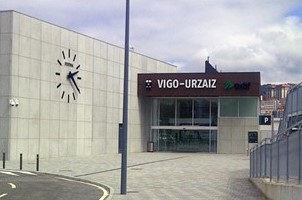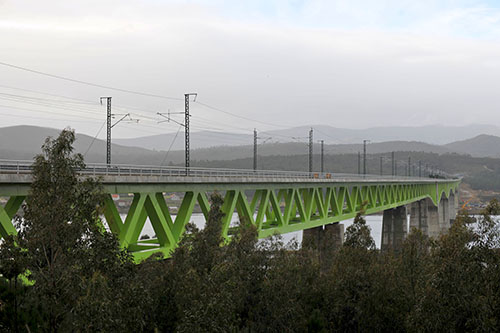Atlantic Corridor
Galicia from North to South
Galicia from North to South
The Atlantic Corridor runs 241 km from north to south on the Atlantic coast of Galicia, between Ferrol and the Portuguese border, connecting five of the seven largest Galician cities. This infrastructure is connected to the new Madrid - Galicia connection at the level of Santiago de Compostela.
The entire route of the Atlantic Corridor between Vigo and A Coruña, with a total length of 155.6 km, is already in commercial service, leading to significant savings in travel times for all connections, while increasing comfort by establishing optimal rolling and layout conditions.
The distance between Vigo and A Coruña has been shortened by 21.8 km. In December 2009, the route for diesel traction trains between Santiago and A Coruña (61.7 km) came into service. Later on, in December 2011, this section was electrified and then connected with and included in the new Ourense-Santiago-A Coruña line.
European Funding
"A way to make Europe"
Stations
The station, with a surface area of 1,330 m2, has all the necessary services for the traveller, a café and shops, and access to the definitive gates and platforms.
This Corridor combines refurbished stations with other newly-built ones:
- A Coruña - Refurbished
- Uxes -Refurbished
- Cerceda-Meirama - New construction
- Ordes - New construction
- Santiago de Compostela - Refurbished
- Padrón-Barbanza - New construction
- Villagarcía de Arousa - Refurbished
- Pontevedra - Refurbished
- Arcade Halt - Refurbished
- High Speed Round - New construction
- Vigo-Urzáiz - New construction
Infrastructure
High speed travel was not possible on the old route of the conventional line, with a single non-electrified track. The project involved comprehensive improvement of the existing line and implementation of a double electrified track.
Unusually, in the first place, the non-electrified track-bed with multi-service Iberian gauge (1,668 mm) was built. This type of gauge enables the access of freight trains, for example, to Galician ports.
The different sections came into service as the construction finished and have been used by diesel trains running at 160 km/h. Later, they were electrified and went from a possible maximum speed of 160 km/h to 250 km/h.
The last stage planned is the adaptation of the entire gauge to the UIC gauge (1,435 mm).
The Atlantic Corridor is built through an area with a complicated terrain and densely populated areas.
The A Coruña-Vigo section has 37 tunnels, that make up a total length of 59.2 km, accounting for 38% of the total route. In the Vigo-Santiago section there are another 24 tunnels, with an overall length of 39.7 km (33% of the total).
Likewise, the line has 32 viaducts that add up to a length of 14.9 km (9.5% of the total length). The Vigo-Santiago section has 24 viaducts, with a length of 12.2 km (13% of the total). The longest is Sar (2,411 m), but the one that is surely the most emblematic is Ulla (1,620 m), which holds a world record for being the metal railway bridge with the longest span (distance between piers), at 240 m, longer than the 208 m of the Nautenbach Bridge (Germany).
This 1,621.5 m viaduct crosses the Ulla River near its estuary. It has 11 piers that support the metallic structure, located at a height of 60 metres over the river. Because of the complexity of the deck's metal structure, with more than 20,000 tonnes of steel and pieces with edges measuring up to 17.5 m, an execution control system was developed that is pioneering in Spain. This viaduct was awarded the "San Telmo 2015" prize and was an Outstanding Structure Award 2016 finalist, recognised by the Association for Bridge and Structural Engineering (IABSE).





